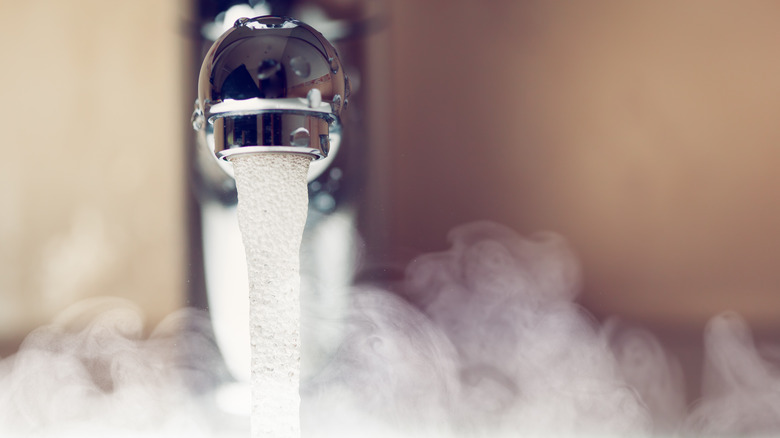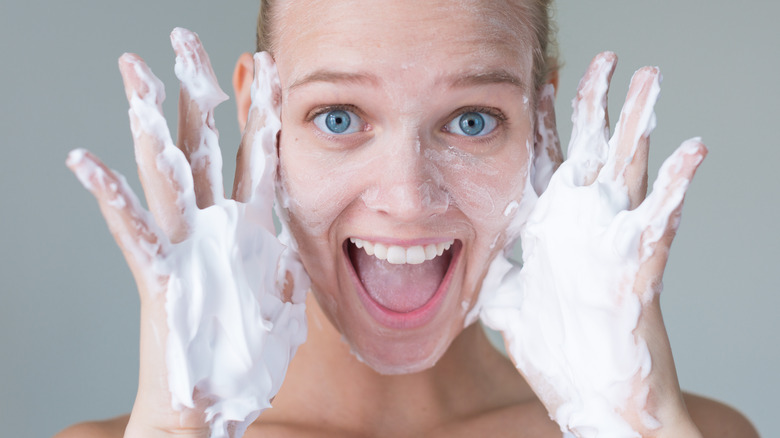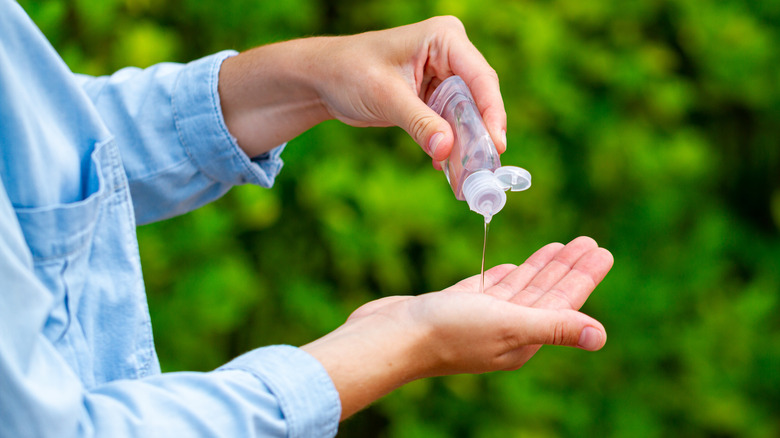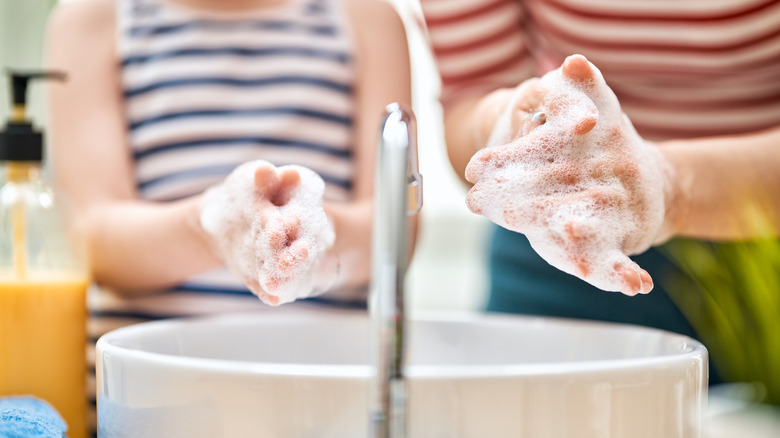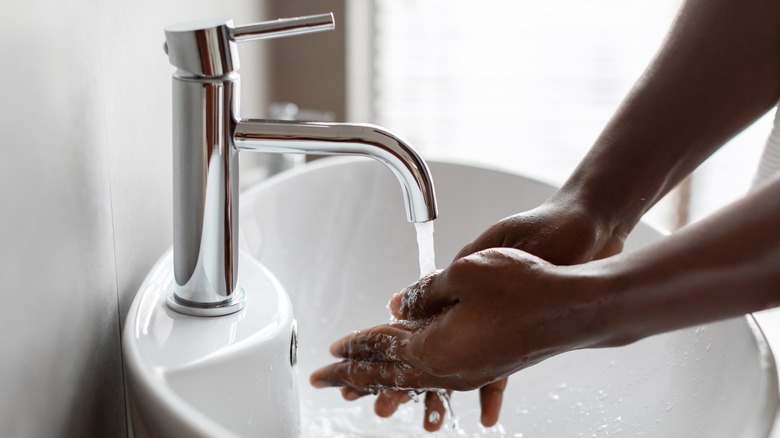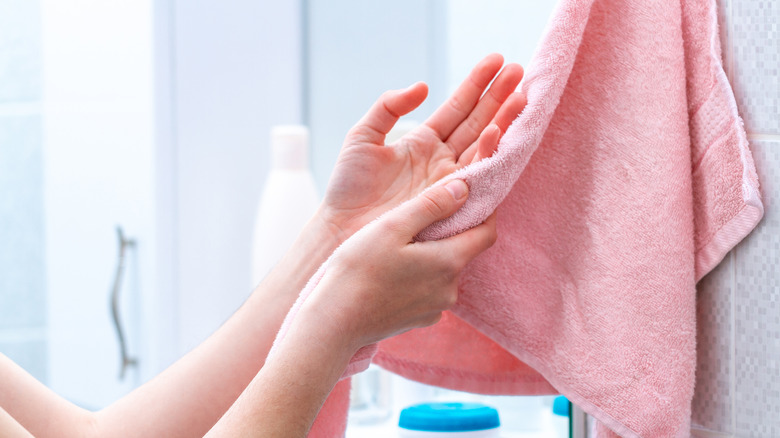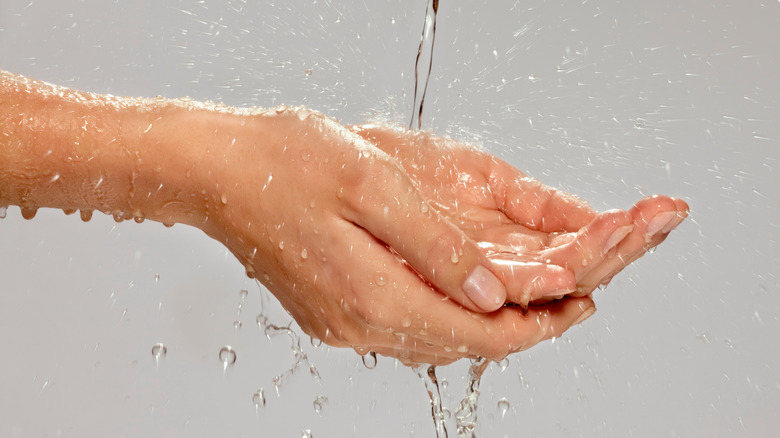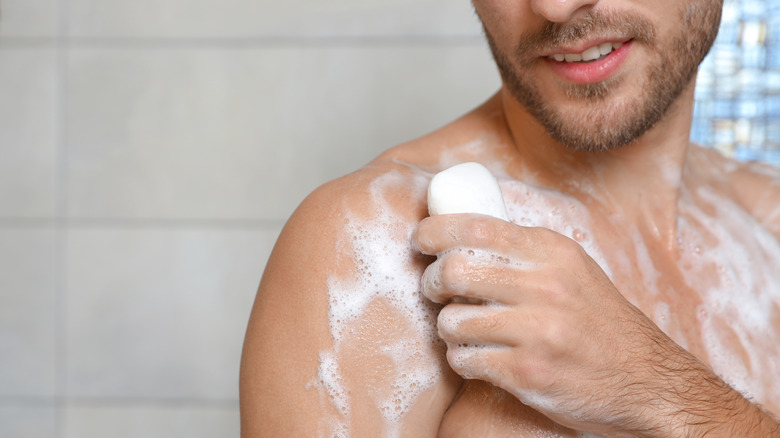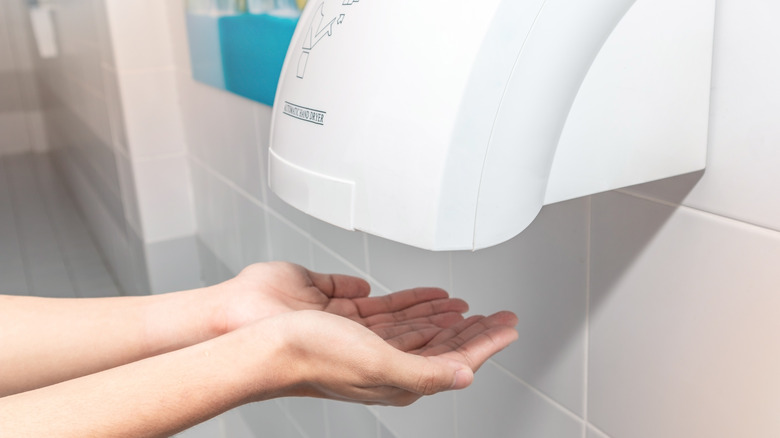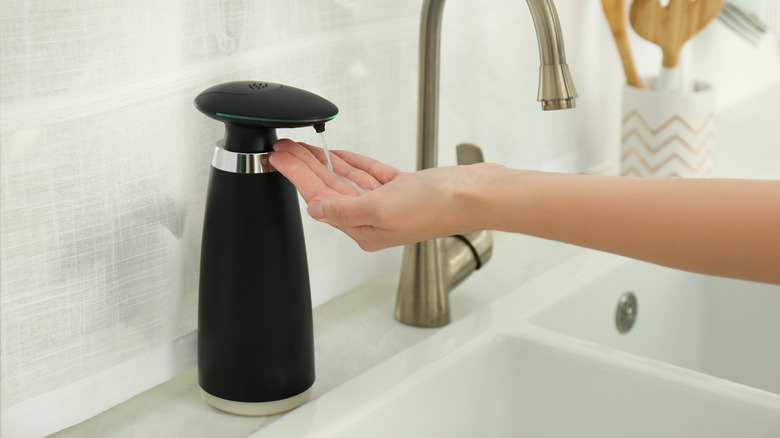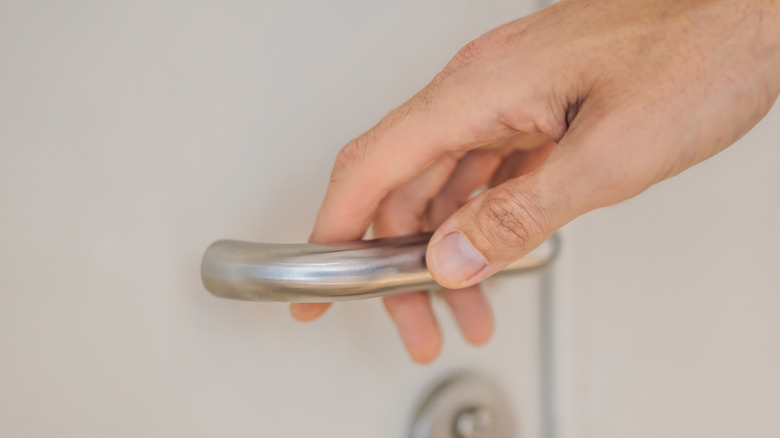Hand-Washing Mistakes You Should Avoid
Don't you wish there was something really simple you could do to keep yourself healthy? It turns out there is: Wash your hands. Before you even get out of your home in the morning, your hands have touched countless household items — doorknobs, cabinets, toilet levers, TV remotes, and more. Each one of them is a breeding ground for germs. When those nasty bugs are gathered in enough numbers, the Mayo Clinic says these disease-causing organisms can make you sick and also spread illness to others if you don't practice good hand hygiene.
The simple fact is if we all would wash our hands a lot more regularly, and in the correct way, those two things alone can prevent about 30% of diarrhea-causing illnesses and about 20% of colds and other respiratory infections, says the Centers for Disease Control and Prevention (CDC). But is it really that simple? Let's give this subject a deep dive and hear from the experts about the hand-washing mistakes you should avoid.
Washing only with hot water
Do you need to use hot (or even warm) water to effectively clean your hands? The answer from a Vanderbilt University study published in the International Journal of Consumer Studies says nope, nada, no. The Vanderbilt researchers focused on wasteful energy usage and greenhouse gas emissions caused by needlessly using hot water for hand washing and concluded that any benefits from the practice were negligible. "The level of heat required to neutralize pathogens is beyond what is considered safe for prolonged human contact," revealed Amanda R. Carrico, the lead author of the study.
Even the superior sudsing action from warm water versus cold didn't make much difference in removing harmful bacteria. The level of lather is irrelevant, the researchers concluded. Unless you're a doctor scrubbing in for surgery, ordinary clean hands are achieved simply by washing, rinsing, and drying them properly.
"Multiple federal and state organizations recommend using elevated water temperatures, in some cases citing its superior cleaning ability as the reason," the Vanderbilt team says — but the evidence seems clear that there's no health benefit. Researchers in an earlier study by Rutgers University in the Journal of Food Protection concluded the same thing: There's no difference between cool, warm, or hot water when washing your hands.
Using too much soap
A little bit of soap is good, so a lot of it should be even better, right? The experts say the hard truth is — not really. If you use an overabundance of soap as part of your cleaning ritual, you'll just end up with inflamed and irritated hands, says Eat This, Not That!
Soap breaks up the oils and bacteria on our skin, which we then rinse away with water. Using too much soap though is the wrong move because it makes it harder to thoroughly remove the lather. The residue can linger on the skin and trigger itchy contact dermatitis. "Most dermatologists caution against using too much soap in the first place, as it can worsen dryness and eczema in people that are prone to those conditions," says board-certified dermatologist Dr. Shirley Chi to Well+Good.
So follow the Goldilocks Principle (per Psychology Today) and go for the middle ground. Don't use too little or too much soap in your hand-washing routine. Use just the right amount instead for the best and most consistent results.
Thinking hand sanitizer is better than soap
We've all become accustomed now to squirting some sanitizing gel on our hands when we're out and about. Should we even bother with old-fashioned soap and water anymore? Well, yes absolutely we should! The clear goop in the convenient bottles comes in second to soap, declares UCI Health. One reason for that is most people don't use hand sanitizer correctly. It's not good enough to squirt a little on your fingers and palms. To do it right, according to Penn Medicine, you have to coat your entire hand — between the fingers, the back of the hands, the palms, and all over the fingertips — then let that gel fully dry. The complete process should take about 20 seconds, the same time as actual hand washing.
"Hand sanitizer may help reduce the number of microbes on your hands, but only in ideal conditions when used as directed on the package," says Michigan State University. Although sanitizing gels can be effective against COVID-19, they don't kill all bad bacteria or viruses. For example, norovirus commonly causes foodborne gastrointestinal illnesses on cruise ships and in healthcare facilities, but it's not killed by alcohol-based sanitizers (via USC Health Alert).
Not washing your whole hand
Have you ever paid attention to the way you actually wash your hands? Is it a rushed dip into a stream of water, a pump of hand soap, and barely two seconds of friction across the palms before you rinse off the lather? Hey, we've all got busy lives, things to do, and people to see — but if that's your usual routine, it's not good enough. To see if your method passes the germ test, just check out the recommended technique of Dr. Gregory Poland, a Mayo Clinic infectious disease expert. If that's already your style, we are very impressed!
With COVID-19 seemingly here to stay, plus our usual cold and flu seasons, lathering up your hands thoroughly and getting into the nooks and crannies of your fingers and palms can really make a difference in maintaining your health (per the National Health Service).
"Washing your hands is a simple, effective way of eliminating germs and reducing the risk of spreading viruses and bacteria that can cause illness," says the Lompoc Valley Medical Center in California. "Your skin is your body's first line of defense when it comes to keeping you healthy."
Not washing your hands long enough
It's one of the most important ways we have to keep illness at bay, yet how many of us lather up our hands for just a few seconds followed by a quick rinse? The CDC warns that type of rushed technique is not enough to do a thorough cleansing. So how long is an adequate amount of time to do the job right? The experts say one of the easiest ways to ensure proper hand-washing time is humming the "Happy Birthday" song twice to yourself (or you can sing it out loud if you're an extrovert). This will help you hit the 20-second goal for hand washing.
Still, 95% of people in a Michigan State University observational study did not take enough time in washing their hands to effectively kill germs. Researchers who published their findings in the Journal of Environmental Health say the actual hand-washing time was a scant six seconds. Even more shocking was that 15% of men (and 7% of women) didn't wash their hands at all after using a public restroom, The Healthy reports.
Not washing your hands often enough
As simple as it is to wash your hands, many people still don't do it when they should. A poll of 24,000 Americans by YouGov, an international research data and analytics group based in London, found that just 58% of respondents say they always wash their hands after using their home bathroom, while 4% say they rarely do. Further, one 2018 study in six test kitchens by the U.S. Department of Agriculture found that about 67% of participants failed to clean their hands at times when it would be recommended to prevent cross-contamination during meal preparation, and among those who did hand wash, only about 2% cleansed thoroughly enough. Yikes!
It may seem pretty obvious (because it is), but washing your hands is essential in the preparation of food, before and after eating, after blowing your nose or coughing, when taking care of a sick person, and after using the toilet, says the CDC. And that's just the shortlist!
Your hand towels aren't very clean
When was the last time you washed your hand towels? If you can't remember, then it's been too long. When you rub your hands dry on a towel, the skin cells you leave behind — plus the moisture from your hands — become food for microbes that multiply quickly. If others are sharing the towel too, or if it is not getting laundered often enough, there will be a natural build-up of skin cells on the cloth that can harbor pathogenic bacteria (via Time).
Frequent laundering of hand towels is a good general practice to adopt, not only because it keeps them fresh and clean smelling, but it may just save you from getting a serious illness like the staph infection MRSA. One study published in The Lancet Infectious Diseases found that sharing bath towels increased MRSA risk by a whopping 25%. Likewise, E. coli was also found in over a quarter of kitchen hand towels in a different study in Food Protection Trends.
Jason Tetro, a microbiologist and author known as The Germ Guy, told Well+Good that once a week is usually sufficient for changing towels. However, if you share hand towels with other family members or guests, then you'll want to change them more frequently — such as twice a week — recommends Melissa Homer, the chief cleaning officer at MaidPro.
Not using soap
You might think immersing your hands under the clean, running water of the faucet would be enough to slide nasty germs right off your hands. But you'd be incorrect. It actually does matter if you use soap — and the right amount of it — to get the job done (via The New York Times). Just as you probably wouldn't take a shower without soap (unless there was no alternative), why would you even consider cleansing without soap, or using only a dab of it, on the one part of your body that touches hundreds of surfaces a day?
Dr. Aileen Marty, a professor of infectious diseases at Florida International University, told Newsweek that the active ingredients in soap "create a chemical reaction that grabs onto the germs, so they rinse right off with the lather." Choose liquid soap over bar soap, she recommends, as bar soap can become contaminated if not rinsed off and dried properly between uses.
In addition to the soap ingredients that capture the millions of germs that live on your hands, the friction created when you wash (and vigorously dry your hands) also helps along the cleaning process, explains the Minnesota Department of Health.
Not rinsing your bar of soap
Bar soap is not a bad thing at all, but it should be rinsed off before and after you use it. According to the Minnesota Department of Health, disease-causing organisms can grow on wet bar soap. But there's a fix for that: Run the bar under the stream of water before you lather your hands with it. "The germs are generally washed down the drain, making it safe to use," says registered nurse Elaine L. Larson, professor emerita and special lecturer at Columbia University School of Nursing, to The Healthy. Larson also advises you store your bar soap in an environment where it's more likely to dry out, rather than a closed container that will retain moisture.
Though it's unlikely for you to pick up a disease from bar soap, adds Philip Tierno, a clinical professor of microbiology and pathology at NYU Langone Health, it is "theoretically possible," he told Self. However, it's more plausible if you're sharing a communal bar of soap among household members or in a public space. To lessen your odds of picking up any nasty microorganisms, he suggests you allow bar soap to thoroughly dry between uses to minimize microbial growth.
You're not completely drying your hands (or you're using an air dryer)
The friction from washing and drying your hands is essential to remove germs, according to the Minnesota Department of Health. It's pretty easy to get your hands totally dry with a paper towel, but it's increasingly common to only have air dryers available in public restrooms. Though they seem like a good idea, studies have shown that these devices may actually make things worse by blowing around microbes.
The results from a small 2021 study published in Infection Control & Hospital Epidemiology showed that it's much more likely to contaminate your hands and your clothes when you dry your hands with a jet air dryer instead of using an ordinary paper towel. An earlier study in Applied and Environmental Microbiology and a Mayo Clinic Proceedings review also suggested that air dryers are less effective than paper and may blow spores from bathroom surfaces onto your freshly washed hands.
"Any type of microbe that has increased longevity on surfaces is always concerning when you have big motors on," says Dr. Christina Johns, senior medical adviser for PM Pediatrics in Annapolis, Maryland. Especially so, she told The Washington Post, for "particles that have settled and are not yet wiped down with a bleach wipe."
Touching your face with unwashed hands
Most of us touch our face something like 23 times an hour, according to the Association for Professionals in Infection Control and Epidemiology. This behavioral quirk of humans becomes a problem when you touch a contaminated surface and then touch your t-zone — the eyes, nose, and mouth — as it's a direct path for pathogens to latch onto your mucus membranes and cause a respiratory infection.
"Scratching the nose, rubbing your eyes, leaning on your chin and your fingers go next to your mouth — there [are] multiple ways we do it," explains Dr. Nancy C. Elder, a professor of family medicine at Oregon Health and Science University in Portland, to The New York Times. "Everybody touches their face, and it's a difficult habit to break."
You can do an amazing job washing up, but as soon as you handle anything like a doorknob, a chair, a keyboard, or your phone, you've re-contaminated your hands yet again. So the experts recommend that if you can just stop doing that one thing — touching your face — you'll immediately reduce your exposure to common infections, reports the The Washington Post.
Only using antibacterial soap
Soaps that contain ingredients that are antimicrobial or antibacterial actually do more harm than good by creating drug-resistant superbugs, according to Monash University in Australia. Outside of a healthcare setting, there's really no need to use anything stronger than plain soap and water for washing your hands, confirms the Minnesota Department of Health.
"Consumers may think antibacterial washes are more effective at preventing the spread of germs, but we have no scientific evidence that they're any better than plain soap or water," confirms Dr. Janet Woodcock, principal deputy commissioner at the Food and Drug Administration (FDA) and former director of its Center for Drug Evaluation and Research.
By just using ordinary soap, you're doing a heap of good by not contributing to bugs that can dodge antibiotics and other drugs, plus you're also getting your hands really clean. It's the lather from soap and friction from scrubbing that kills the germs and washes them away down the drain, says the CDC, and isn't that the ultimate goal?
Touching the bathroom door handle right after washing
Want to hear something gross? About 10% of Britons have never cleaned their bathroom door handle, according to a survey of 2,000 people across the United Kingdom (via House Beautiful). The U.S. isn't doing much better in the hygiene department. Apartment Guide conducted a poll of 3,000 Americans and found that 22% admitted to not bothering to wash their hands after using the toilet in their home. And what's the first things these people probably touch after going to the bathroom? Yep, the door handle.
It's not just unwashed hands that make a bathroom door handle dirty — the flushing action of the toilet is responsible for some of it, too, says Charles Gerba, a professor of microbiology and environmental sciences at the University of Arizona, to The New York Times. Aerosolized plumes containing bacteria and viruses can spray five feet from toilets and hover in the air for over an hour, settling on bathroom surfaces like countertops and door handles. In public restrooms, electric hand dryers then keep those particles suspended in the air with each blast of their jets. If that isn't an incentive to grab the door handle with a paper towel, we don't know what is.
Not washing your hands after handling pet food
Survey results from over 400 dog owners in a study conducted by North Carolina State University College of Veterinary Medicine found that only a third of fur parents washed their hands after feeding their dogs (via PLOS One). Few were aware of the FDA's food and bowl handling guidelines, or even that foodborne cross-contamination can occur between humans and pets. A different survey published in the Journal of Food Protection received similar results. Standard hand-washing routines and hygiene seem to go out the window when it comes to our fur friends.
The problem with this lack of hygiene with pets (besides being gross) is that it can lead to a lot of gastrointestinal illnesses, reports Purdue University. But much like food for humans, pet food can be contaminated with potentially harmful pathogens, including salmonella and listeria (via Self). So wash your hands before and after preparing Fido's breakfast and dinner, and clean out his bowl with soap and water after every meal.


